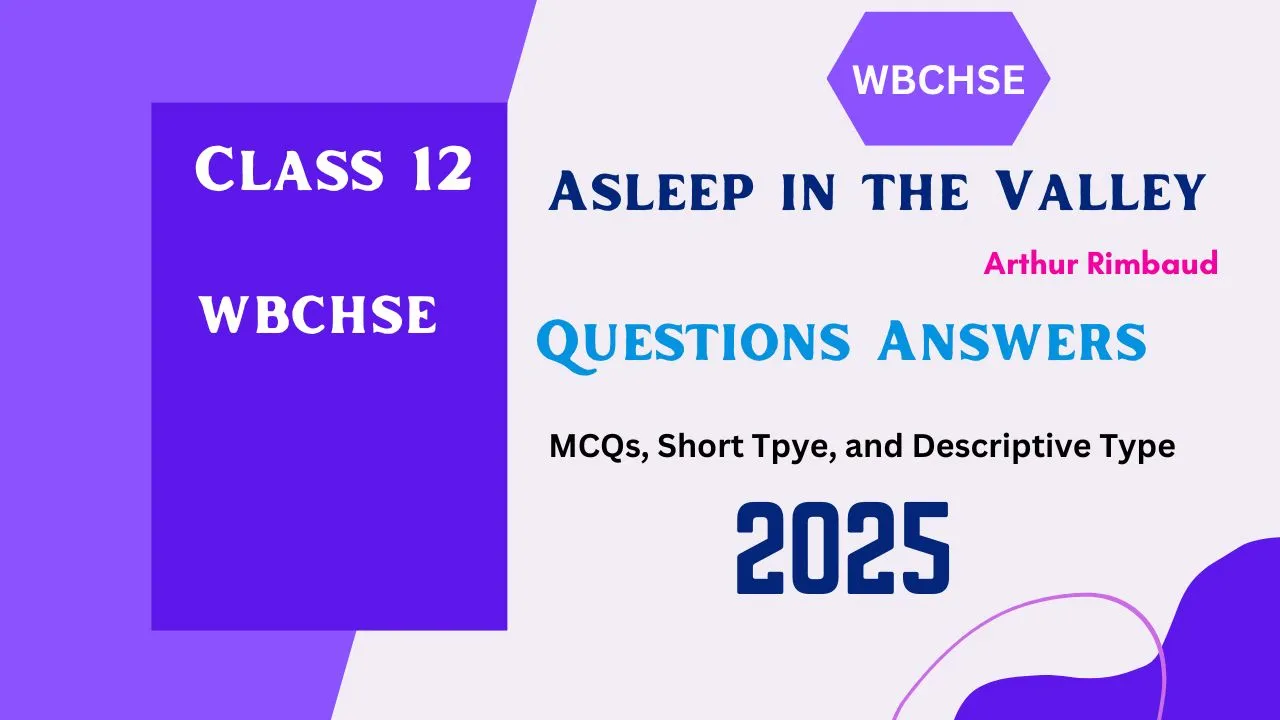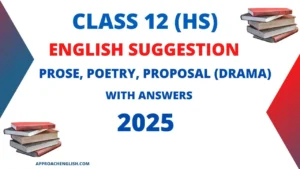Asleep in the Valley Class 12 Questions and Answers WBCHSE is a comprehensive study guide for the 2025 exam. It includes MCQs, SAQs, and LAQs with detailed explanations, following the latest exam trends. This resource helps students strengthen their understanding and prepare effectively for their exams.
Asleep in the Valley Class 12 Questions Answers MCQ Type Questions:
1. The smile of the soldier in the poem ‘Asleep in the Valley’ is- (a) gentle (b) witty (c) foolish (d) cunning [HS 2015]
Ans: (a) gentle
2. The soldier lies in the valley because he is a- (a) winner in the war (b) casualty of war (c) sleeping person (d) chocolate cream soldier
Ans: (b) casualty of war
3. The dead soldier was- (a) not very young (b) middle-aged (c) very young (d) an aged person
Ans: c) very young
4. The poet requests Nature- (a) to lull the soldier to sleep (b) to disturb the soldier’s sleep (c) to make the soldier catch cold (d) to keep the soldier warm
Ans: (d) to keep the soldier warm
5. The feet of the dead soldier lay among the- (a) leaves (b) flowers (c) ferns (d) thorns
Ans: (b) flowers
6. The soldier’s pillow is made of- (a) flowers (b) fern (c) grass (d) leaves [HS 2017]
Ans: (b) fern
7. One hand of the soldier is on his- (a) face (b) gun (c) breast (d) side [HS 2016]
Ans: (c) breast
8. “… gentle, without guile.”-‘without guile’ means- (a) pure and innocent (b) kind and childish (c) harsh and cruel (d) manly
Ans: (a) pure and innocent
9. The sun’s rays flow from- (a) the sky (b) the valley (c) the mountain stream (d) the heaven
Ans: (b) the valley
10. The words ‘red holes’ mean- (a) spots of blood clots (b) red flowers in the valley (c) bullet wounds (d) none of these [2020]
Ans: (c) bullet wounds People also search
11. The stream flows through the valley (a) in a zigzag course (b) at a slow pace (c) swiftly (d) in a halting manner [HS 2023]
Ans: (b) at a slow pace
12. The marks of the wound of the soldier are (a) on his head (b) on his chest (c) in his side (d) in his leg [HS 2022]
Ans: (c) in his side
13. Nature is pleaded to keep the soldier (a) pleasant (b) warm (c) asleep(d) peaceful [HS 2022]
Ans: (b) warm
Asleep in the Valley Class 12 Questions Answers Short Types Questions
1. What do the ‘two red holes’ in the poem, ‘Asleep In The Valley’ signify?
Ans: In the poem, Asleep In the Valley’ ‘two red holes’ signify the marks of bullet wounds of the dead soldier.
2. What is the soldier’s pillow made of?
Ans: The soldier’s pillow is made of ferns.
3. “…they fill the hollow full of light.”-What does ‘the hollow’ describe?
Ans: The ‘hollow’ referred to in the poem, Asleep in the Valley’ describes a beautiful valley on which the sun gleams brightly.
4. Why is the soldier pale?
Ans: The soldier is pale because he is dead.
5. “The humming insects don’t disturb his rest.” – Why?
Ans: The humming insects don’t disturb the soldier’s rest because he is already dead.
6. What does the slow stream leave on the bright grass?
Ans: The slow stream leaves long strands of silver on the bright grass.
7. Why does the poet ask Nature to keep the soldier warm?[HS 2016]
Ans: The poet asks Nature to keep the soldier warm so that he does not catch cold.
8. Where does the stream leave ‘long strands of silver’?[HS 2017]
Ans: The slow stream leaves long strands of silver on the bright grass.
9. What is described as ‘gentle, without guile’?[HS 2017]
Ans: The smile of the soldier is described as gentle, without guile.
10. How is the bed of the dead soldier?
Ans: The bed of the dead soldier is warm, green and sun-soaked.
11. Where are the feet of the soldier placed? [HS 2020, 2015]
Ans: The feet of the soldier are placed among the flowers.
People also ask
| HS English Suggestion 2025 with Answers Prose Poetry Drama |
| Class 12 English Writing Suggestion 2025 Answer WBCHSE |
| Higher Secondary (H S) English Textual Grammar Suggestion 2025 |
12. What is the soldier’s smile compared to? [HS 2020]
Ans: The soldier’s smile is compared to an infant’s smile.
13. Why is the soldier pale? [HS 2022]
Ans: The soldier is pale in Arthur Rimbaud’s “Asleep in the Valley” because he has lost his life in battle. The paleness signifies the lifelessness and absence of vitality, emphasizing the stark contrast between the soldier’s once-vibrant existence and the now-still reality of death in the poem.
14. Where does the soldier lie stretched? [HS 2022]
Ans: The soldier lies stretched in the valley, as described in Arthur Rimbaud’s “Asleep in the Valley.”
15. What is seen on the side of the soldier? [HS 2023]
Ans: On the side of the soldier in Arthur Rimbaud’s “Asleep in the Valley,” there are two red holes, indicative of gunshot wounds from the violence of war.
16. How does the stream look like in the poem, “ Asleep in the Valley”? [HS 2016]
Ans: In “Asleep in the Valley” by Arthur Rimbaud, the stream is described as clear, shallow, and reflecting the peaceful surroundings of the valley, creating an image of natural serenity.
Asleep in the Valley Class 12 Questions Answers Subjective/Descriptive Types
1. “His smile is like an infant”-Whose smile is referred to here? Why is his smile compared with that of an infant? How does nature treat him? [HS 2019]
Ans: In Arthur Rimbaud’s “Asleep in the Valley,” the smile referred to is that of the deceased young soldier. His smile is compared to that of an infant to evoke a sense of innocence and purity, emphasizing the youthfulness of the soldier who met an untimely death in war. Rimbaud uses this comparison to evoke empathy for the tragic loss of youthful life. Nature treats the fallen soldier with a gentle touch; the poet describes how Nature spreads a green coverlet over him, providing a peaceful and nurturing resting place, despite the harshness of war that led to his demise.
2. Justify the title of the poem, ‘Asleep In The Valley!
Ans: The title “Asleep in the Valley” is justified by Arthur Rimbaud as it captures the profound contrast between the tranquility of nature and the harsh realities of war. The valley serves as a peaceful resting place for a young soldier who has succumbed to the violence of battle. The term “asleep” implies a peaceful repose in death, suggesting a serene and undisturbed rest in the lap of nature. Rimbaud’s choice of title encapsulates the irony of finding solace in the valley despite the unsettling circumstances, underscoring the tragic juxtaposition between the beauty of the natural world and the devastating consequences of war.
3. How does the poet Arthur Rimbaud look upon war?
/Or, Justify Asleep In The Valley as an anti-war poem.
Or, Discuss the central idea of the poem, ‘Asleep In The Valley’.
Or, How does the poet express the futility of war? What message does he want to convey? [HS 2018] 4+2
Ans: Arthur Rimbaud expresses the futility of war in “Asleep in the Valley” through poignant and vivid imagery. The peaceful valley, described in contrast to the brutality of war, becomes the final resting place for a young soldier. The soldier’s innocent smile and the serene surroundings highlight the tragic waste of youth in conflict. The poet conveys a message of the senselessness of war, portraying nature’s beauty as a stark contrast to the violence and suffering it witnesses. Rimbaud’s powerful portrayal emphasizes the futility of sacrificing young lives in war, urging reflection on the devastating consequences and questioning the purpose of such destructive conflicts.
4. “They fill the hollow full of light.”-What is the ‘hollow’ referred to here? How does the hollow look? Who is lying in the hollow? How is he lying there? 1+2+1+2
Or, Give a brief description of the surroundings where the soldier lay in the poem ‘Asleep In The Valley.
Ans: In “Asleep in the Valley” by Arthur Rimbaud, the surroundings where the young soldier lies are painted with vivid natural imagery. The valley is described as peaceful and idyllic, adorned with lush greenery, wildflowers, and a meandering river. Nature, seemingly untouched by the ravages of war, provides a stark contrast to the grim reality of the young soldier’s fate. The valley becomes a poignant backdrop, emphasizing the tragic disruption of innocence amid the tranquility of the landscape. Rimbaud’s skillful use of imagery creates a powerful juxtaposition, underscoring the impact of war on the individual and the intrusion of conflict into the serene beauty of the natural world.
5. “Ah, Nature, keep him warm; he may catch cold.”-Who is he? Why may he catch a cold? Why does the poet ask Nature to keep him warm? 1+2+3
Ans: In the poem “Asleep in the Valley” by Arthur Rimbaud, the line “Ah, Nature, keep him warm; he may catch cold” refers to the young soldier who lies in the valley. The soldier, being deceased, is beyond the warmth and care of the living. Rimbaud, in a touch of poignant irony, addresses Nature as if it were a nurturing force. The soldier may “catch cold” symbolically suggests the soldier’s vulnerability even in death. The poet’s plea to Nature conveys a sorrowful wish for comfort and protection for the fallen soldier, highlighting the tragic contrast between the serenity of nature and the harshness of war’s consequences.
6. “A soldier very young, lies open-mouthed.” -Who is the ‘soldier’ referred to here? Describe the place where the soldier lies. Why does he lie ‘open-mouthed’? Who takes care of him and how? 2+4 [ HS 2023]
Ans: In the poem “Asleep in the Valley” by Arthur Rimbaud, the ‘soldier’ mentioned is a young man who has lost his life in battle. The soldier lies in a picturesque valley, surrounded by the beauty of nature—a stark contrast to the brutality of war. His ‘open-mouthed’ position may symbolize the abruptness of his death or the silenced voices of the fallen. Nature is personified as caring for him, as Rimbaud implores it to keep the soldier warm. However, the soldier remains lifeless, and the poet’s plea serves to underscore the tragedy of war, where even the peaceful embrace of nature cannot revive the fallen.
7. “In his side there are two red holes.”-Who is the person referred to here? What do the ‘two red holes’ signify? What attitude of the poet to war is reflected here? [HS 2017] 1+2+3
Ans: In Arthur Rimbaud’s poem “Asleep in the Valley,” the person referred to is the young soldier who has succumbed to the ravages of war. The ‘two red holes’ indicate gunshot wounds on the soldier’s side, vividly portraying the violence and fatal impact of conflict. Rimbaud’s portrayal reflects an anti-war sentiment, as he presents the stark reality of a young life cut short by warfare. The poet’s use of such graphic imagery and the emphasis on the soldier’s vulnerability convey a critical attitude towards war, denouncing its destructive nature and lamenting the tragic consequences it inflicts on the youth who become its victims.
8. “The humming insects do not disturb his rest.”-Who rests and where? What puts him to rest? Why can’t the insects disturb [HS 2020] 1+2+3
Ans: In Arthur Rimbaud’s poem “Asleep in the Valley,” the line “The humming insects do not disturb his rest” refers to the young soldier who lies in the peaceful valley. The soldier rests in death, having succumbed to the violence of war. The insects, often associated with the bustling and vibrant activity of nature, do not disturb him because he is no longer alive. His rest is permanent, and the stillness of death contrasts with the usual disturbance caused by living beings. This creates a poignant image of the soldier’s eternal tranquility in death, emphasizing the profound contrast between the serenity of nature and the harshness of war.
9. “…… His smile
Is like an infant’s…
” Whose ‘smile’ is being referred to here? Explain the comparison in the given lines. How does Nature take care of him ? 1+3+2 [HS 2022]
Ans: In Arthur Rimbaud’s poem “Asleep in the Valley,” the “smile” being referred to belongs to the deceased young soldier. The comparison to an infant’s smile suggests innocence and purity, emphasizing the youthfulness of the soldier who met an untimely death in war. Rimbaud uses this image to evoke empathy and sorrow for the loss of youthful potential.
Nature takes care of the soldier in a gentle and poignant way. The poet describes how Nature spreads a green coverlet over him. This imagery implies that Nature provides a comforting and peaceful resting place for the fallen soldier, highlighting the contrast between the brutality of war and the nurturing embrace of the natural world.
10. “In his side there are two red holes” Who is the person referred to here? What do the two red holes’ signify ? What attitude of the poet to war is reflected here? 1+2+3 [HS 2022]
Ans: In Arthur Rimbaud’s poem “Asleep in the Valley,” the person referred to is a young soldier who has fallen in battle. The “two red holes” in his side signify gunshot wounds, vividly portraying the violent and fatal nature of war. Rimbaud’s portrayal reflects an anti-war sentiment, as he uses graphic imagery to convey the devastating impact of conflict on young lives. The poet’s depiction of the soldier’s injuries is a poignant commentary on the senseless destruction wrought by war, reflecting a critical attitude towards the brutality and tragedy inherent in armed conflict.







